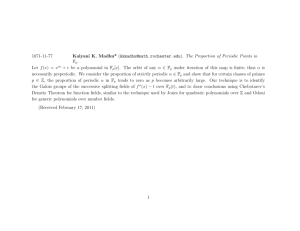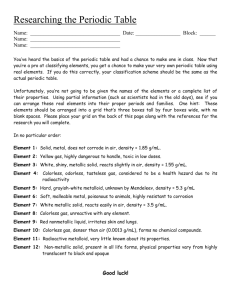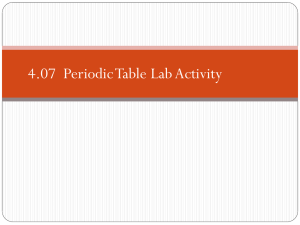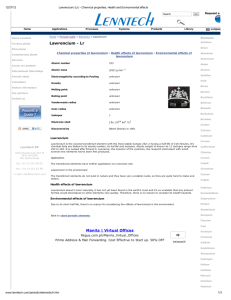170. Misapplying the Periodic Law
advertisement
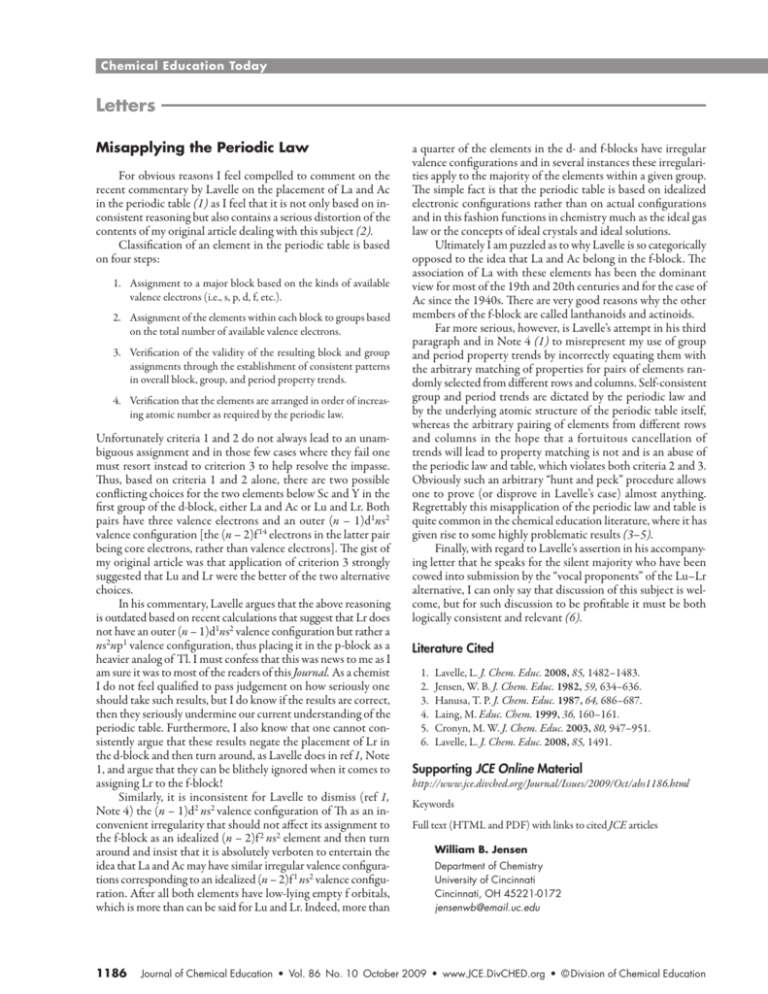
Chemical Education Today Letters Misapplying the Periodic Law For obvious reasons I feel compelled to comment on the recent commentary by Lavelle on the placement of La and Ac in the periodic table (1) as I feel that it is not only based on inconsistent reasoning but also contains a serious distortion of the contents of my original article dealing with this subject (2). Classification of an element in the periodic table is based on four steps: 1. Assignment to a major block based on the kinds of available valence electrons (i.e., s, p, d, f, etc.). 2. Assignment of the elements within each block to groups based on the total number of available valence electrons. 3. Verification of the validity of the resulting block and group assignments through the establishment of consistent patterns in overall block, group, and period property trends. 4. Verification that the elements are arranged in order of increasing atomic number as required by the periodic law. Unfortunately criteria 1 and 2 do not always lead to an unambiguous assignment and in those few cases where they fail one must resort instead to criterion 3 to help resolve the impasse. Thus, based on criteria 1 and 2 alone, there are two possible conflicting choices for the two elements below Sc and Y in the first group of the d-block, either La and Ac or Lu and Lr. Both pairs have three valence electrons and an outer (n – 1)d1ns2 valence configuration [the (n – 2)f 14 electrons in the latter pair being core electrons, rather than valence electrons]. The gist of my original article was that application of criterion 3 strongly suggested that Lu and Lr were the better of the two alternative choices. In his commentary, Lavelle argues that the above reasoning is outdated based on recent calculations that suggest that Lr does not have an outer (n – 1)d1ns2 valence configuration but rather a ns2np1 valence configuration, thus placing it in the p-block as a heavier analog of Tl. I must confess that this was news to me as I am sure it was to most of the readers of this Journal. As a chemist I do not feel qualified to pass judgement on how seriously one should take such results, but I do know if the results are correct, then they seriously undermine our current understanding of the periodic table. Furthermore, I also know that one cannot consistently argue that these results negate the placement of Lr in the d-block and then turn around, as Lavelle does in ref 1, Note 1, and argue that they can be blithely ignored when it comes to assigning Lr to the f-block! Similarly, it is inconsistent for Lavelle to dismiss (ref 1, Note 4) the (n – 1)d2 ns2 valence configuration of Th as an inconvenient irregularity that should not affect its assignment to the f-block as an idealized (n – 2)f 2 ns2 element and then turn around and insist that it is absolutely verboten to entertain the idea that La and Ac may have similar irregular valence configurations corresponding to an idealized (n – 2)f 1 ns2 valence configuration. After all both elements have low-lying empty f orbitals, which is more than can be said for Lu and Lr. Indeed, more than 1186 a quarter of the elements in the d- and f-blocks have irregular valence configurations and in several instances these irregularities apply to the majority of the elements within a given group. The simple fact is that the periodic table is based on idealized electronic configurations rather than on actual configurations and in this fashion functions in chemistry much as the ideal gas law or the concepts of ideal crystals and ideal solutions. Ultimately I am puzzled as to why Lavelle is so categorically opposed to the idea that La and Ac belong in the f-block. The association of La with these elements has been the dominant view for most of the 19th and 20th centuries and for the case of Ac since the 1940s. There are very good reasons why the other members of the f-block are called lanthanoids and actinoids. Far more serious, however, is Lavelle’s attempt in his third paragraph and in Note 4 (1) to misrepresent my use of group and period property trends by incorrectly equating them with the arbitrary matching of properties for pairs of elements randomly selected from different rows and columns. Self-consistent group and period trends are dictated by the periodic law and by the underlying atomic structure of the periodic table itself, whereas the arbitrary pairing of elements from different rows and columns in the hope that a fortuitous cancellation of trends will lead to property matching is not and is an abuse of the periodic law and table, which violates both criteria 2 and 3. Obviously such an arbitrary “hunt and peck” procedure allows one to prove (or disprove in Lavelle’s case) almost anything. Regrettably this misapplication of the periodic law and table is quite common in the chemical education literature, where it has given rise to some highly problematic results (3–5). Finally, with regard to Lavelle’s assertion in his accompanying letter that he speaks for the silent majority who have been cowed into submission by the “vocal proponents” of the Lu–Lr alternative, I can only say that discussion of this subject is welcome, but for such discussion to be profitable it must be both logically consistent and relevant (6). Literature Cited 1. 2. 3. 4. 5. 6. Lavelle, L. J. Chem. Educ. 2008, 85, 1482–1483. Jensen, W. B. J. Chem. Educ. 1982, 59, 634–636. Hanusa, T. P. J. Chem. Educ. 1987, 64, 686–687. Laing, M. Educ. Chem. 1999, 36, 160–161. Cronyn, M. W. J. Chem. Educ. 2003, 80, 947–951. Lavelle, L. J. Chem. Educ. 2008, 85, 1491. Supporting JCE Online Material http://www.jce.divched.org/Journal/Issues/2009/Oct/abs1186.html Keywords Full text (HTML and PDF) with links to cited JCE articles William B. Jensen %FQBSUNFOUPG$IFNJTUSZ 6OJWFSTJUZPG$JODJOOBUJ $JODJOOBUJ0) jensenwb@email.uc.edu Journal of Chemical Education t 7PM /P 0DUPCFS t XXX+$&%JW$)&%PSg t ª%JWJTJPOPG$IFNJDBM&EVDBUJPn Chemical Education Today Letters Response to Misapplying the Periodic Law My commentary titled “Lanthanum (La) and Actinium (Ac) Should Remain in the d-Block” (1) was intended to make clear to those who cite Jensen (2) that placing lanthanum and actinium in the f-block is not majority accepted or without problems. Hopefully, this answers Jensen’s question as to why I wrote this commentary. Also, my “commentary” was submitted and treated as a reviewed article with four reviewers selected by this Journal, of which three recommended publication as is. However it was this Journal’s editorial decision to publish the article as a commentary. Unfortunately, critics of my commentary are now under the impression that it was not peer reviewed and therefore incorrectly assume or imply that its contents are my opinion only. I am surprised that Jensen openly states that lawrencium’s calculated atomic ground state of [Rn]5f 14 7s2 7p1 is “news” to him. Jensen should read the publications I referenced. The NIST periodic table, which I also referenced, also indicates this electron configuration for lawrencium, in addition to the placement of lutetium and lawrencium in the f-block. Quoted from the article by Fritzsche and co-workers (3), “…there are little doubts today about the 7s2 7p 2P½° ground level of atomic lawrencium…”. However this “news” goes back to the 1970s (e.g., 4) and 1980s (e.g., 5). As a result of this calculated ground state, the computed properties of lawrencium and its compounds are predicted to be similar to thallium (6). But let me be very clear, as I did in my commentary, I am not advocating that lawrencium be moved to the p-block or anywhere else. It is Jensen and those who use his 1982 publication (2) that want to change the positions of lanthanum, actinium, lutetium, and lawrencium from their current positions in the periodic tables adopted by IUPAC, NIST, and many reference resources. The point of my discussion on lawrencium was that those who insist on placing lutetium and lawrencium in the d-block, and insist that others also do so, are selective in the literature they cite to support their claim. I agree with Jensen’s four points on classifying elements in the periodic table. I used and stated equivalent principles that this Journal emphasized in bold, call-out text (1), “The placing of elements in the periodic table is currently accepted as a combination and balance of factors including the following empirical observations: atomic number, properties, periodic trends, and atomic ground-state electron configuration.” It is therefore incomprehensible why Jensen has titled his letter to me, “Misapplying the Periodic Law”, perhaps a catchy title but one that is incorrect. Jensen infers that the historical record favors his placing of lanthanum and actinium in the f-block (resulting in his placement of lutetium and lawrencium in group 3 in the d-block). However, several well-known reference books clearly show lanthanum and actinium in group 3 in the d-block. For example, the periodic table in the Handbook of Chemistry published 1946 (7) places scandium, yttrium, lanthanum, and actinium in (and titled) “Group III B” (now often referred to as group 3). In addition, the CRC Handbook of Chemistry and Physics, which I have access to many editions published 1968–2008, all show the placement of lanthanum and actinium in group 3 in the d-block. If Jensen and others categorically opposed to the idea of lanthanum and actinium in group 3 in the d-block are not satisfied with that historical record, there is the 1st edition of the CRC Handbook of Chemistry and Physics published 1913 (8), in which page 70 is titled “Periodic Arrangement of the Elements—Mendelejeffs (Revised to 1911)” and in it scandium, yttrium, and lanthanum are in (and titled) “Group III”. Reference resources, both old and new, place scandium, yttrium, lanthanum, and actinium in the d-block in group 3 with their common +3 oxidation state. Because the most common oxidation state of the subsequent f-block elements, cerium–lutetium and thorium–lawrencium, are also +3 and often found in the same ore deposits, they were referred to as lanthanides and actinides, respectively, or more recently lanthanoids and actinoids. To answer Jensen’s indirect question, the origin of these collective names are fine with me, although periodic tables do not need to include these names, just as they do not include other collective names such as alkali metals, halogens, and so forth. Regarding my sentiment on flexibility towards the periodic table, in my letter (9) that Jensen cites, I wrote, “Perhaps our university chemistry textbooks should include brief mention of the difficulties on having one form of the periodic table.” To be clear, my position is that we use well-established forms of the periodic table (IUPAC, NIST, CRC Handbook of Chemistry and Physics) in chemistry textbooks and classrooms, and authors and educators can discuss alternative placements of elements, as well as discuss the limitations of these widely used periodic tables. To suggest otherwise may result in a Pandora’s box of a never-ending multitude of different periodic tables. On the topic of the IUPAC (1, 9, 10), nothing is perfect and the IUPAC has its faults. It is not a scientific–empirical approach for authors to emphasize IUPAC’s mistakes and completely ignore its contributions. Jensen’s letter (10) “The Periodic Table: Facts or Committees” has a catchy title but ignores the fact that wellrespected chemists such as Herb Kaesz and Peter Atkins sit on IUPAC committees. Jensen appears to be unaware of the self-righteous content of some of his publications in this Journal that detracts from his otherwise many historically informative publications. Literature Cited 1. Lavelle, L. J. Chem. Educ. 2008, 85, 1482–1483. 2. Jensen, W. B. J. Chem. Educ. 1982, 59, 634–636. 3. Fritzsche, S.; Dong, C. Z.; Koike, F.; Uvarov, A. Eur. Phys. J. D 2007, 45, 107–113. 4. Brewer, L. J. Opt. Soc. 1971, 61, 1101–1111. 5. Desclaux, J. P.; Fricke, B. J. de Physique 1980, 41 (9), 943–946. 6. Balasubramanian, K. J. Chem. Phys. 2002, 116, 3568–3575. 7. Handbook of Chemistry, 6th ed., Lange, N. A., Ed.; Handbook Publishers: Sandusky, OH, 1946; p 58. 8. CRC Handbook of Chemistry and Physics, 1st ed., Lide, D. R., Ed.; CRC Press: Boca Raton, FL, 1913; p 70. 9. Lavelle, L. J. Chem. Educ. 2008, 85, 1491. 10. Jensen, W. B. J. Chem. Educ. 2008, 85, 1491–1493. Supporting JCE Online Material http://www.jce.divched.org/Journal/Issues/2009/Oct/abs1187.html Keywords; Full text (HTML and PDF) with links to cited JCE articles Laurence Lavelle Department of Chemistry and Biochemistry University of California Los Angeles Los Angeles, CA 90095-1570; lavelle@chem.ucla.edu © Division of Chemical Education t www.JCE.DivCHED.org t Vol. 86 No. 10 October 200 t Journal of Chemical Education 1187



